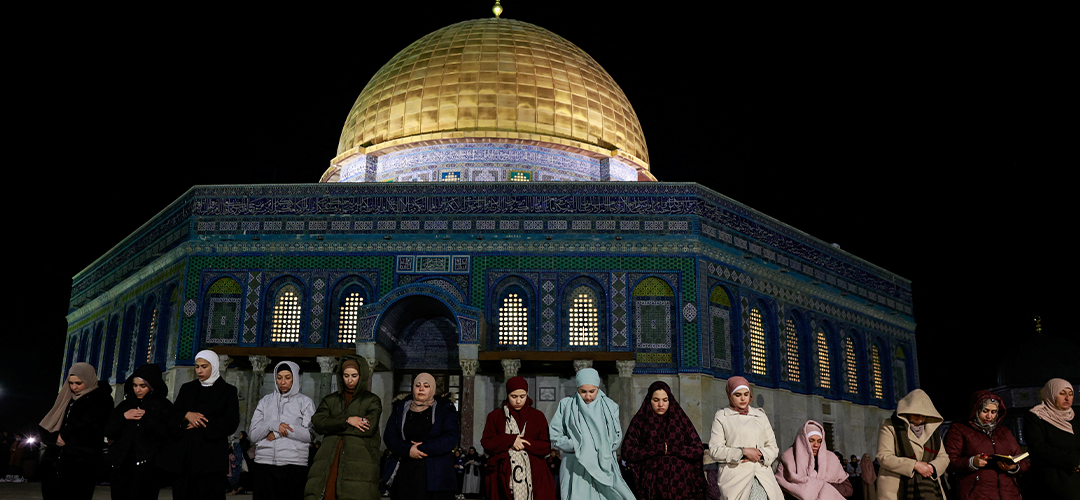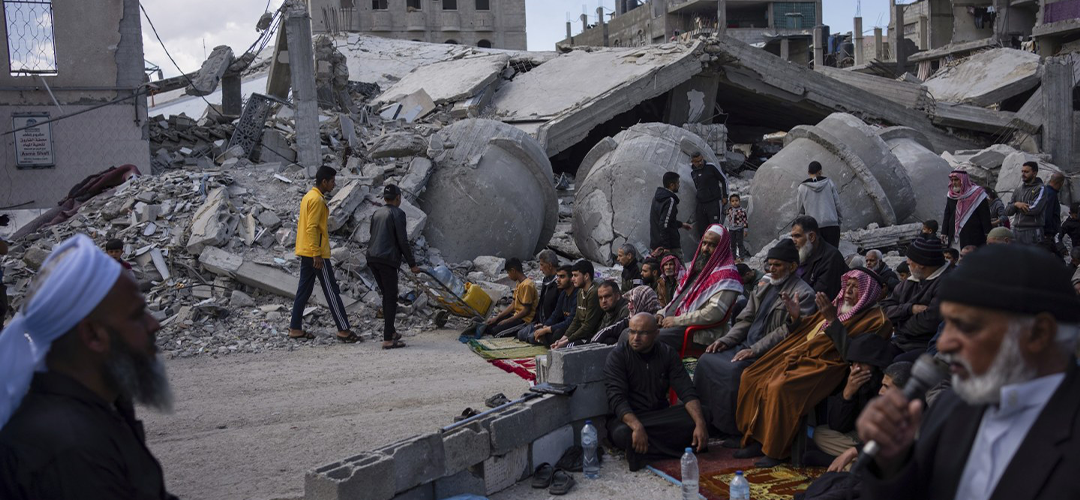Ramadan Season
March 16, 2024 | Expert Insights

After failed attempts to broker a truce before the holy month of Ramadan, tensions remain high in the West Bank and Gaza Strip. Officials and peace mediators had hoped that a ceasefire during Ramadan would have brought stability to the area and allowed for the delivery of humanitarian aid. The outcomes of the peace negotiations between Egypt, Qatar, and the United States appear dubious given the ongoing nature of the war. Amid the fighting in the Gaza Strip, Ramadan had begun. 2 million people are starting the traditional fasting period, therefore it's alarming that they won't have access to food and drink after dusk. People have consumed cattle feed to quell their hunger and prevent starvation. Reports by the UN and aid groups suggest very few supplies enter Gaza on account of Israel’s blockade and near-total siege. After the creation of a maritime aid corridor, Open Arms, the ship equipped with humanitarians headed towards Gaza from Cyprus.
Background
The British mandate of Palestine was to be divided into an Arab state and a Jewish state according to the Partition Plan, which was approved by UN Resolution 181 in 1947. The State of Israel was subsequently established on May 14, 1948. This led to conflicts between Israel and Palestine that continue to this day. The third Arab-Israeli conflict took place in the region in 1967 during the Six-Day War.
Other wars ensued after them. On the holy days of Ramadan and Yom Kippur in 1973, Egypt and Syria initiated the Yom Kippur War, also known as the October War. The US and the Soviet Union were both invited to participate indirectly in the region during the Yum Kippur War. A UN peacekeeping team was sent to create a buffer zone to uphold regional peace. After multiple cease-fires and peace talks, Israel and Egypt signed the 1979 Camp David Accords, a peace treaty.
The Second Intifada began in 2000 with Palestinians revolting against Israeli occupation. The period witnessed instability characterized by heightened violence in the region and lasted until 2005. In retaliation, a wall was built around the West Bank in 2002. Israel was condemned for its actions by the ICC and the ICJ. After the 2006 elections, Hamas was elected, deposing Fatah in the Gaza Strip, resulting in escalated factionalism. Hamas’s victory failed to be recognized by the West. After the Israel-Hamas confrontation in 2014, Palestinian President Abbas declared the Oslo Accords redundant and ineffective.
There has been bloodshed in the region for several years. Following the 1993 adoption of the Oslo Peace Process accord, peace negotiations between Israel and Palestine advanced between the 1990s and 2010. Because of the mutual hostility between the two groups, there are border disputes, problems with settlement, crises within the Palestinian enclaves, refugee crises, and security challenges.
Israel's retaliation after Hamas’s unprecedented attack on the 7th of October has continued with the deaths of over 30,000 Palestinians and 1,500 Israelis. Hamas still holds more than 130 hostages in captivity, including 32 bodies. In retaliation, Israeli forces have expanded and intensified their ground operation in the Gaza Strip, even during the holy season of Ramadan.

Analysis
Domestic politics in Israel and Palestine heavily influenced their external reactions. The number of Israeli settlements steadily increased in occupied Palestinian territories, which was violently countered by Hamas. The conflict has metastasized and spread into neighbouring areas.
The advent of Ramadan has forced Israel to increase the entry of humanitarian aid into the Strip. However, the IDF has imposed arbitrary criteria and seized essentials from entering, revealing an obstructive pattern. Dehydration and malnutrition have become the primary killers of children, as predicted by the United Nations. Serious deliberation and negotiation for a cease-fire before Ramadan have failed. The United Nations warned of a severe spillover of the conflict in the region, calling all parties to exercise restraint in hopes of de-escalating the situation in the region.
With the increase in violence, escalation in the West Bank regions has drastically surged as Israel Defense Forces (IDF) have intensified their operation in the region. With violence swelling from both sides, data shows an increase in fatality rates, with settler violence on the rise.
Tensions between Israel and Lebanon have heightened with the exchange of fire across the Blue Line, risking border escalation and affecting regional stability. Experts have predicted a wider regional conflagration, and with the involvement of Kezbulla and the Houthies, more proxy players are bound to get involved. Aggressive attacks by the Houthis in the Red Sea towards US and UK vessels have caused them to retaliate. The region is witnessing several catalytic reactions, with the effects of the conflict spilling over into other territories. After an attack on some elite Iranian force members, Iran launched an attack against Syria and Iraq in retaliation.
Around 85% of the population of Gaza has been displaced, Lebanon has hosted several displaced people as the crisis grows within parts of Lebanon, and citizens are getting internally displaced. All this, coupled with cross-border artillery firing and drone attacks in Lebanon, is making the situation more tense. The simmering pot is now boiling over’ was the expression used to describe the current realities and geopolitical order in Gaza. This Ramadan season will witness Palestinian children breaking their fast with scrapes found in bins.
Assessment
- The conflict is by no means nearing its As we have entered the spillover phase, players wanting to capitalize on the situation have entered and made their presence known.
- The primary risk of escalation arises from a potentially misguided attack initiated by the US and its allies or Iran and its proxies.








Comments